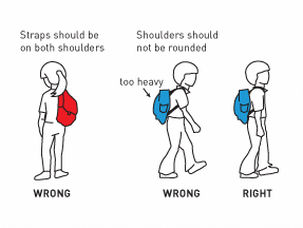Is Your Child’s Backpack too Heavy?
Can you believe that summer is already over and we’ve started another new school year? It sure seems like summer flew by.
I even look back on my previous article called Backpack Basics and I cannot believe that it’s been over a year since I’ve posted that.
However, one of the things that I’ve noticed with each school year is that backpacks only seem to get heavier and heavier.
Now, don’t get me wrong, I love seeing the kids go back to school, but each year that your child’s bag gets heavier, I have to admit that I get more and more concerned with how their spines are affected by this.
As a matter of fact, our spines don’t stop ‘growing’ until we’re about 18. And for some, this could extend as far as age 25.
With that said, it’s important to keep an eye on how your child is wearing their backpack. Is their backpack sitting too low? Do you notice them hunching over as they wear it?
All of these can be good indications that your child’s backpack is far too heavy for them.
In today’s post, I’m going to explain the warning signs of a heavy backpack. By identifying these signs early on, you could prevent future back injuries later down the line. Plus, as I mentioned in this article, a spine that’s out of alignment could be contributing to other conditions—such as asthma, allergies, learning disorders, hyperactivity and bed wetting—in addition to back pain.
To put things into perspective for you, the Huffington Post tells us that, “At least 14,000 children are treated for back-related injuries every year,” and that, “Improperly used backpacks may injure muscles and joints and can lead to severe back, neck and shoulder pain, as well as posture problems.”
Now that you know how backpacks can be damaging to your child’s health, it’s time to learn how to keep them safe. Here are three warning signs that your child’s backpack is just too heavy.
Where does the backpack sit?
Take a look at your child’s backpack when it’s full. Where does the backpack sit? Ideally, you want it to sit 1 inch above the waist. If their bag sits below their hips or buttocks, there’s a good chance that’s it’s pulling on their shoulders and neck and could be causing harm.
Can they stand up straight?
As I mentioned earlier, if you notice a forward lean when your child has their backpack on, then it may be a bit too heavy for them. Your child should be able to stand up straight (with the backpack just above the waist) without any trouble. Any rounding of the back could be putting unnecessary tension on their shoulders, neck and back.

Are the straps loose?
The straps on your child’s backpack are extremely important since they will be supporting a majority of the weight of the bag. Loose straps can cause the bag to sit too low or may not provide enough support altogether.
Therefore, it’s a good idea to test the straps before reusing a backpack.
Here’s how you can test it out: add a few household books (cookbooks work great) to your child’s bag and guesstimate how much weight they’ll carry on a daily basis. Now, test the straps by having your child try the loaded bag on. Do the straps feel loose even though you’ve tightened them? Are the straps holding up the weight or does your child feel the excess weight on your their low back? Their answers to these questions can help you determine if it’s time for a new bag with more supportive straps.
If you do decide that it’s time to buy a new backpack this school year, here are few things to keep in mind.
Final Tips
-
Choose lightweight materials such as canvas instead of leather
-
Opt for supportive, thick straps instead of thin ones. You can even buy gel filled ones that offer even more support
-
Choose a bag with a padded back if possible
-
Make sure the straps adjust enough for the bag to sit at the proper height
-
Ask your child’s teachers what books they’ll need to complete their homework. If the books are heavy and needed on a regular basis, you may want to purchase a bag with wheels instead
To wrap things up, your child’s backpack has more of an effect on their well-being than most of us would imagine.
Take a few moments to check out their bag once it’s fully loaded and ask yourself the three questions above. If you notice any warning signs, then it’s time for a more supportive replacement.
If you do suspect that your child’s posture could be affecting them, give our office a call and schedule a consultation today. We’d be happy to check their spine to make sure they start the school year off right.




Leave a Reply
Want to join the discussion?Feel free to contribute!